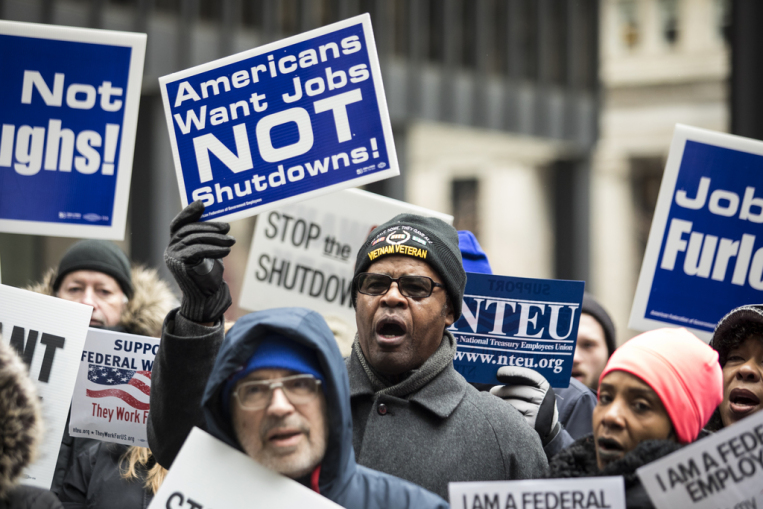“How Do We Untangle This Mess?”
Policies and Parties Clash Over Border Funding
Photo Credit: Ashlee Rezin/ Chicago Sun-Times
Despite President Trump’s assertion that federal workers “agree 100% with what I’m doing”, thousands of employees have taken to the streets in protest as the shutdown continues into Friday.
January 11, 2019
Border Security. The Wall. Government Shutdown. By now, these words have a familiar ring to millions of people across America. They are the words that have fueled what will ultimately be the longest government shutdown in American history, with Friday’s 21 day mark matching Clinton’s 21 day shutdown back in 1995. However this time, there seems to be no quick or easy end in sight.
All this madness started late last month when Trump refused to sign a bipartisan spending bill allocating only 1.7 billion dollars to the border wall, rather than his desired 5.7 billion. Since December 22nd, the government has entered a partial shutdown, affecting more than 800,000 federal workers who have now gone almost three weeks without pay, some of which have still been required to show up to work even without the promise of a paycheck. This Friday, paychecks won’t go out to thousands of federal workers that live paycheck to paycheck, creating potentially disastrous economic conditions.
With so many government workers directly influenced and an additional 4.1 million people who contract with the government also out of work, it seems that everyone knows someone affected, even Boise High students.
For sophomore Hope Strohmeyer, it’s personal. Both her parents work wildfire related land management jobs for the government and have been furloughed due to the shutdown.
She explains that the shutdown most closely affects her family because “my parents and their coworkers are unsure if they will be paid after the shutdown.”
However, she also worries about a larger impact the shutdown might have on fire preparation for this summer, claiming that, “My parents use this time to prepare for the upcoming fire season such as hiring and contracting. They will be behind on this process when fire season does come and that will affect the safety and effectiveness of wildland fire this upcoming summer.”
US Bureaucracies like the Department of the Interior, Homeland Security, Justice and Treasury,, have been affected both locally and nationally by the shutdown. These hard hitting departments control National Parks, TSA security and money programs like food stamps and taxes.
Despite the fact that National Parks are officially closed, masses of tourists are still flooding past welcome gates. Without park officials on duty, trash is piling up, restroom conditions are quickly deteriorating, and 7 people have died because of reckless behavior and a lack of supervision over tourists. As for airport security, since TSA agents won’t receive their paychecks Friday, many workers have refused to show up to the job, causing TSA worker shortages across the country. With Friday quickly looming, many worry that some airports could potentially close if boycotting continues.
In his first prime time address to the nation, Trump offered no solutions or compromises to bring the shutdown to a close. In a firm but heartfelt tone, Trump appealed to Americans’ heartstrings, claiming that, “This is a humanitarian crisis. A crisis of the heart and a crisis of the soul.” He remained true to his claim that “This barrier is absolutely critical to border security” and repeatedly asserted that a physical barrier is the only way to halt the thousands of illegal immigrants he claims try to enter our country every day.
Immediately following Trump’s address, newly elected Speaker of the House Nancy Pelosi and Senate Minority Leader Chuck Schumer addressed the American public, most critically advocating that, “there is no excuse for hurting millions of Americans over a policy difference” and “separate the shutdown from arguments over border security.” Both sides seemed fixed in their way of thinking and unwilling to find compromise.
However, there is one tactic Trump seems to think can get him the funding for his campaign-promised border wall. And that’s obtaining the funds for the wall without congressional approval. The only possible way for that to happen would be if Trump declared a state of emergency, which will likely face legal challenges immediately, but Trump seems set on that strategy if it comes down to it. Thursday afternoon Trump told reporters that “If [talks with Democrats] don’t work out, probably I will do it, I would almost say definitely. This is a national emergency.”
On the other side, Jared Kushner, senior White House advisor and wife to Trump’s daughter Ivanka, met with Democrats Thursday to discuss a possible scenario where Democrats fund the wall in exchange for the DACA program being reinstated. However, these talks have not manifested into agreements yet.
Perhaps Chuck Schumer did the best job of summing up the problem America is facing right now. In his rebuttal, he started by asking the American public, “How do we untangle this mess?”
And right now, I’m not sure anyone knows the answer to that question.














Catherine D Serio • Feb 2, 2019 at 11:45 am
Outstanding article!